|
|
 |
|
Calanoida ( Order ) |
|
|
|
Metridinidae ( Family ) |
|
|
|
Metridia ( Genus ) |
|
|
| |
Metridia brevicauda Giesbrecht, 1889 (F,M) | |
| | | | | | | Ref.: | | | Giesbrecht, 1892 (p.340, 346, 773, figs.F,M); Giesbrecht & Schmeil, 1898 (p.108, Rem. F,M); Farran, 1908 b (p.60); A. Scott, 1909 (p.120, figs.F); Farran, 1926 (p.271); Sewell, 1932 (p.248); Wilson, 1932 a (p.118, figs.F,M); Rose, 1933 a (p.179, figs.F); Jespersen, 1934 (p.101); Lysholm & al., 1945 (p.32); Farran, 1948 c (n°14, p.3, figs.F); Brodsky, 1950 (1967) (p.300, figs.F,M); Vervoort, 1957 (p.122, Rem.); Tanaka, 1963 (p.19, figs.F,M); Owre & Foyo, 1967 (p.70, figs.F,M); Grice & Hulsemann, 1967 (p.17, 28: Rem.); Vinogradov, 1968 (1970) (p.195, 261); Vaupel-Klein, 1970 (p.4, 34); Minoda, 1971 (p.36); Arcos, 1975 (p.18, figs.F [non M]); Björnberg & al., 1981 (p.640, figs.F); Chihara & Murano, 1997 (p.837, tab.6); Bradford-Grieve & al., 1999 (p.884, 948, figs.F,M); Bradford-Grieve,1999 b (p.112, figs.F,M, Rem., figs.177, 192); Vives & Shmeleva, 2007 (p.360, figs.F,M, Rem.) | 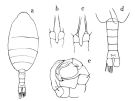 issued from : O. Tanaka in Publs Seto Mar. Biol. Lab., 1963, XI (1). [p.19, Fig.157]. Female: a, habitus (dorsal); b, P5; c, P5 (another specimen). Nota: urosome segments and furca are in the proportional lengths as 43:17:17:23 = 100. Male: d, last thoracic segment and urosome (dorsal); e, P5.
|
 issued from : J.M. Bradford-Grieve in The Marine Fauna of New Zealand: Pelagic Calanoid Copepoda. National Institute of Water and Atmospheric Research (NIWA). NIWA Biodiversity Memoir, 111, 1999. [p.113, Fig.75]. Female (29°03.5'S, 168°36'E): A, habitus (right lateral side); B, urosome (dorsal); C, exopod segment 3 of P4; D, P5. Male (30°45'S, 173°16'E): E, habitus (dorsal); F, P5 (L = left leg; R = right leg). Nota: The Southwest Pacific specimens agree with Giesbrecht's description, but with some small differences (cf. p.112).
|
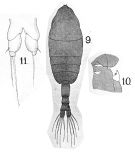 issued from : A. Scott in Siboga-Expedition, 1909, XIX a. [Plate XXXVII, Figs.9-11]. Female (from Indonesia-Malaysia): 9, habitus (dorsal); 10, P2 (hooks on basal segment of endopodite); 11, P5.
|
 issued from : D.F.R. Arcos in Gayana, Zool., 1975, 32. [Lam.V, Figs.46-47]. Female (from Bahia de Concepcion, Chile): 46, P; 47, endopodite segment 1 of P2.
|
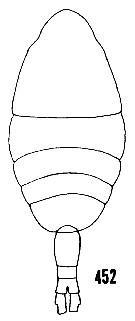 issued from : H.B. Owre & M. Foyo in Fauna Caribaea, 1967, 1, Crustacea, 1: Copepoda. [p.71, Fig.452]. Female (from Florida Current): 452, habitus (dorsal).
|
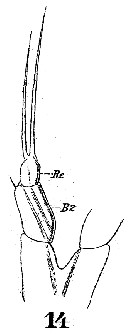 Issued from : W. Giesbrecht in Systematik und Faunistik der Pelagischen Copepoden des Golfes von Neapel und der angrenzenden Meeres-Abschnitte. – Fauna Flora Golf. Neapel, 1892, 19 , Atlas von 54 Tafeln. [Taf.33, Fig.14]. Female: 14, P5.
|
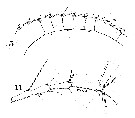 Issued from : W. Giesbrecht in Systematik und Faunistik der Pelagischen Copepoden des Golfes von Neapel und der angrenzenden Meeres-Abschnitte. - Fauna Flora Golf. Neapel, 1892, 19 , Atlas von 54 Tafeln. [Taf.33, Figs.5, 11]. Female: 5, A1 (proximal segments): 11, A1 (distal segments).
|
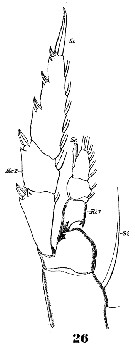 Issued from : W. Giesbrecht in Systematik und Faunistik der Pelagischen Copepoden des Golfes von Neapel und der angrenzenden Meeres-Abschnitte. - Fauna Flora Golf. Neapel, 1892, 19 , Atlas von 54 Tafeln. [Taf.33, Fig.26]. Female: 26, P2 (anterior view).
|
 Issued from : W. Giesbrecht in Systematik und Faunistik der Pelagischen Copepoden des Golfes von Neapel und der angrenzenden Meeres-Abschnitte. - Fauna Flora Golf. Neapel, 1892, 19 , Atlas von 54 Tafeln. [Taf.33, Fig.32]. Female: 32, urosome (ventral).
|
 Issued from : W. Giesbrecht in Systematik und Faunistik der Pelagischen Copepoden des Golfes von Neapel und der angrenzenden Meeres-Abschnitte. - Fauna Flora Golf. Neapel, 1892, 19 , Atlas von 54 Tafeln. [Taf.33, Fig.10]. Male: 10, A1 (distal segments).
|
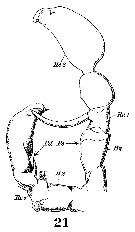 Issued from : W. Giesbrecht in Systematik und Faunistik der Pelagischen Copepoden des Golfes von Neapel und der angrenzenden Meeres-Abschnitte. - Fauna Flora Golf. Neapel, 1892, 19 , Atlas von 54 Tafeln. [Taf.33, Fig.21]. Male: 21, P5 (posterior view).
|
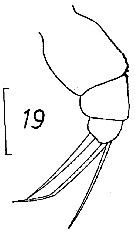 issued from : D.F. Arcos in Rev. Com. Perm. Pacifico Sur, 1976, 5. [Fig. 19]. Female [non Male] (from Isla Riesco): 19, P5. Sxale bar: 50 µ. For Arcos, P5 3-segmented, symmetrical with 3 terminal setae and without outer spines. Border of the last thoracic segment rounded. Remarks: there are some differences between the P5 of this form and that of other authors (variability in the number od setae ?).
| | | | | Compl. Ref.: | | | Cleve, 1904 a (p.192); Pearson, 1906 (p.24); Hardy & Gunther, 1935 (1936) (p.175, Rem.); Wilson, 1942 a (p.193); Sewell, 1948 (p.349, 502, 514, 519, 525, 546, 549, 557, 567); C.B. Wilson, 1950 (p.263); Fagetti, 1962 (p.26); Grice, 1963 a (p.496); De Decker & Mombeck, 1964 (p.13); Grice & Hulsemann, 1965 (p.224); Furuhashi, 1966 a (p.295, vertical distribution in Oyashio/Kuroshio transitional area, Table 8, 9, 10); Fleminger, 1967 a (tabl.1); Park, 1970 (p.477); Roe, 1972 (p.277, tabl.1, tabl.2); 1972 b (p.544); Björnberg, 1973 (p.337, 387); Vives & al., 1975 (p.46, tab.II, XII); Deevey & Brooks, 1977 (p.256, tab.2, Station "S"); Dessier, 1979 (p.206); Vives, 1982 (p.293); Kovalev & Shmeleva, 1982 (p.84); Chahsavar-Archad & Razouls, 1982 (p.38); Roe, 1984 (p.358); Longhurst, 1985 (tab.2); Brinton & al., 1986 (p.228, Table 1); Wishner & Allison, 1986 (tab.2); Lozano Soldevilla & al., 1988 (p.59); Madhupratap & Haridas, 1990 (p.305, fig.3: vertical distribution night/day; fig.7: cluster); Ashjian & Wishner, 1993 (p.483, abundance, species group distributions); Webber & Roff, 1995 (tab.1); Shih & Young, 1995 (p.70); Hure & Krsinic, 1998 (p.61, 101); Padmavati & al., 1998 (p.349); Suarez-Morales & Gasca, 1998 a (p.110); Razouls & al., 2000 (p.343, Appendix); Madhupratap & al., 2001 (p. 1345, vertical distribution vs. O2, figs.4, 5: clusters, p.1353); Holmes, 2001 (p.18); Yamaguchi & al., 2002 (p.1007, tab.1); Shimode & al., 2005 (p.113 + poster); Hwang & al., 2007 (p.24); Fernandes, 2008 (p.465, Tabl.2); Gaard & al., 2008 (p.59, Table 1, N Mid-Atlantic Ridge); Galbraith, 2009 (pers. comm.); Park & Ferrari, 2009 (p.143, Table 5, Appendix 1, biogeography); Homma & Yamaguchi, 2010 (p.965, Table 2); Schnack-Schiel & al., 2010 (p.2064, Table 2: E Atlantic subtropical/tropical); Hidalgo & al., 2010 (p.2089, Table 2); Medellin-Mora & Navas S., 2010 (p.265, Tab. 2); Homma & al., 2011 (p.29, Table 2, abundance, feeding pattern: suspension feeders); Hidalgo & al., 2012 (p.134, Table 2); in CalCOFI regional list (MDO, Nov. 2013; M. Ohman, comm. pers.); Hirai & al., 2013 (p.1, Table I, molecular marker); Lidvanov & al., 2013 (p.290, Table 2, % composition); Bonecker & a., 2014 (p.445, Table II: frequency, horizontal & vertical distributions); Fierro Gonzalvez, 2014 (p.1, Tab. 3, 5, occurrence, abundance); El Arraj & al., 2017 (p.272, table 2); Belmonte, 2018 (p.273, Table I: Italian zones) | | | | NZ: | 21 | | |
|
Distribution map of Metridia brevicauda by geographical zones
|
| | | | | | | | | | | | | | | | | |  Issued from : M. Madhupratap & P. Haridas in J. Plankton Res., 12 (2). [p.310, Fig.3]. Issued from : M. Madhupratap & P. Haridas in J. Plankton Res., 12 (2). [p.310, Fig.3].
Vertical distribution of calanoid copepod (mean +1 SE), abundance No/100 m3. 18- Metridia brevicauda.
Night: shaded, day: unshaded.
Samples collected from 6 stations located off Cochin (India), SE Arabian Sea, November 1983, with a Multiple Closing Plankton Net (mesh aperture 300 µm), in vertical hauls at 4 depth intervalls (0-200, 200-400, 400-600, 600-1000 m). |
| | | | Loc: | | | Antarct. (SW Atlant.), ? Magallanes region (in Arcos, 1976), South Georgia, sub-Antarct. (SW Atlant., Indian, SE Pacif.), South Africa (E), Congo, off S Cape Verde Is., Brazil, off Rio de Janeiro, off Morocco-Mauritania, Canary Is., off Azores, off Madeira, off Portugal, Ibero-moroccan Bay, off W Cabo Finisterre, Bay of Biscay, Caribbean Sea, Jamaica, Caribbean Colombia, G. of Mexico, Florida, Sargasso Sea, off Bermuda: Station ‘S’(32°10’N, 64°30’W), off Cape Hatteras, Woods Hole, S Strait of Davis, S Iceland, Faroe Is., off W Ireland, North Sea, Medit. (S Adriatic Sea: in Grandori, 1913), Arabian Sea, Indian, Bay of Bengal, Indonesia-Malaysia, China Seas (East China Sea, South China Sea), Taiwan (S), Japan, Station Knot, Bering Sea, W Alaska, S Aleutian Basin, S Aleutian Is., Station "P", off British Columbia, off Washington, California, Gulf of California, off W Guatemala, off Peru, Chile (S, off Santiago), New Zealand (off N North Island), Kermadec Is., N Tasman Sea, off S Tasmania | | | | N: | 76 | | | | Lg.: | | | (5) F: 1,9; (22) F: 2,25-1,8; M: 1,65-1,5; (26) F: 1,9; M: 1,5; (38) F: 1,95-1,8; (45) F: 2,25-2; M: 1,65-1,5; (46) F: 2,2-2,1; M: 1,65-1,5; (199) F: 1,9-1,67; M: 1,52; (205) F: 1,9; (208) M: 1,6; (909) F: 1,5-1,88; M: 1,3-1,65; {F: 1,50-2,25; M: 1,30-1,65}
The mean female size is 1.988 mm (n = 16; SD = 0.2933), and the mean male size is 1.547 mm (n = 11; SD = 0.1076). The size ratio (male : female) is 0.79 (n = 6; SD = 0.0573). | | | | Rem.: | meso-abyssopelagic. Sampling depth (Antarct., sub-Antarct.): 500-1000 m. Sargasso Sea: 500-2000 m (Deevey & Brooks, 1977, Station "S"); 200-900 m at Station S 2 in S Bösö (E middle Japan)
After Grice & Hulsemann (1967, p.28) the P5 of several female specimens from Indian Ocean were observed to have 4 rather 3 segments. | | | Last update : 25/10/2022 | |
|
|
 Any use of this site for a publication will be mentioned with the following reference : Any use of this site for a publication will be mentioned with the following reference :
Razouls C., Desreumaux N., Kouwenberg J. and de Bovée F., 2005-2026. - Biodiversity of Marine Planktonic Copepods (morphology, geographical distribution and biological data). Sorbonne University, CNRS. Available at http://copepodes.obs-banyuls.fr/en [Accessed January 06, 2026] © copyright 2005-2026 Sorbonne University, CNRS
|
|
 |
 |














